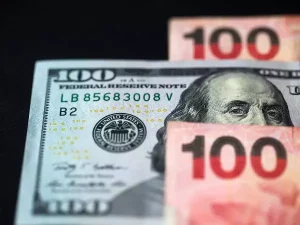
Published November 27, 2023
BRICS member India’s local currency the Rupee is falling to a new low on Monday against the US dollar. The Indian Rupee plummeted to 83.38 as the US dollar gained strength against all the BRICS local currencies this month.
The Rupee is relentlessly experiencing a dip due to various factors including local and international financial pressure. Despite India’s thriving economy, the Rupee’s lackluster performance in the currency market is a cause of worry for the Modi administration.
BRICS: What’s Happening With the US Dollar and the Indian Rupee?
The Rupee’s fall comes after leading global banks and traders were seen bidding for the US dollar and not the Rupee. The move was most likely initiated on behalf of institutional and custodial clients of the global banks. The result led the Rupee to become “sticky in the 5-10 paisa zone near 83.30” said a trader to Reuters.
READ FULL ARTICLE
SOURCE: www.watcher.guru.com
RELATED: Asia Day Ahead: US dollar struggles, NZD/USD retesting upper channel resistance
With the US markets back from its holiday break, greater cues for the risk environment may be presented this week.

Published November 27, 2023
Market Recap
With the US markets back from its holiday break, greater cues for the risk environment may be presented this week. Thus far, major US indices have gained for the fourth straight week, with the S&P 500 looking on track to retest its year-to-date high at just less than 1.5% away. On the other hand, the VIX has pushed to its lowest level since January 2020 as the broader risk-on sentiments prevail. US yields rose slightly, with the 10-year yields back at its 4.50% level, while the US dollar failed to tap on it for a move higher.
The economic calendar last Friday brought a mixed set of purchasing managers index (PMI) readings out of the US, with its manufacturing sector dipping back into contractionary territory (49.4 versus 49.8 forecast) while services activities held firm (50.8 versus 50.4 forecast). The unchanged composite reading of 50.7 from a month ago, alongside signs of cooling employment in the private sector, could point towards limited upward pressures on inflation and support the Federal Reserve (Fed)’s decision to keep rates on hold.
Ahead this week, the US personal consumption expenditures (PCE) price data, which is the Fed’s favoured inflation metric, will help to clarify the extent to which the disinflation process was continuing. It will also be on watch to provide validation for market pricing of rate cuts as early as June 2024. For now, the US dollar continues to struggle around its 200-day moving average (MA), as recent move to reclaim the key trendline did not manage to find much follow-through. Further downside may leave the 102.00 level on watch next, with a declining moving average convergence/divergence (MACD) pointing to prevailing downside momentum for now.
READ FULL ARTICLE
SOURCE: www.ig.com
RELATED: Dollar is still king, but for how much longer?

Published November 26, 2023
Recent deal between China and Saudi Arabia is a small but important step as world wakes up to the consequences of denominating almost all global trade in the American currency
The increasingly close relationship between China and Saudi Arabia has taken another significant step forward. The central banks of both countries have agreed on their first currency swap worth a maximum of 50 billion yuan (HK$55 billion) over the next three years.
In immediate terms, the pact will foster bilateral commerce denominated in both the yuan and the riyal. In the longer term, it augurs a petroyuan future as the two countries are already the most important trading partners of each other. In a global political economy long dominated by the petrodollar, this could be the beginning of a seismic shift. It has been a very long time coming.
Almost a year ago, President Xi Jinping made a historic visit to Riyadh, followed by Hong Kong Chief Executive John Lee Ka-chiu in February. A flurry of deals followed.
READ FULL ARTICLE
SOURCE: www.amp.scmp.com


